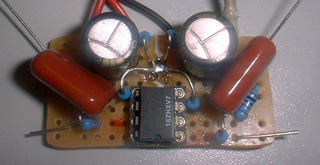Audiologica

Getting Started in Headphone DIY
Getting Started in Audio DIY — If you are thinking about getting into audio DIY, this article tells you what tools and such you will need. It includes recommended tools’ part numbers and more.
Is Amplifying Low-End Sources Worthwhile? — Discusses the tradeoffs in adding a headphone amp to a system with a low-end source. Is a chain only as strong as its weakest link?
How to Build the CMoy Pocket Headphone Amplifier — This is a tutorial on building Chu Moy’s pocket headphone amplifier. This is an excellent choice for your first DIY audio project.
How to Wire Panel Components — Now that you’ve got your amplifier circuit assembled, you need to wire up the switches, knobs, and jacks. This article will help you figure out which wire goes where.
Building a Better Amp
The PIMETA v2 Headphone Amplifier — This design is intended primarily for compact portable amplifiers, though it can scale up easily. The circuit topology is closest to that of the PPA v2, without quite as many bells and whistles. If you want an inexpensive amp that’s easier to put together than any of the others mentioned below, this is the one for you.
The PPA Project — The PPA is a high-end headphone amplifier that works for both stationary and “transportable” amplifiers. There is a companion fast-charging NiMH battery board design, allowing excellent sonics without sacrificing run time despite the PPA amp’s hunger for power. While only the most dedicated audiophile would take it jogging with their iPod, this combination makes for a fine travel amplifier. Back at home, you can continue running on the battery supply to get better sound than wall power allows. Or, you can forego the battery supply entirely: the PPA works fine in a purely stationary configuration with a regular wall supply.
How Do I Make a Distribution Amplifier? — Many people coming to my site actually want to drive several headphones at once, and wind up asking me how they can make one of the above designs do that. That’s called a distribution amp, and I discuss your easiest options in this article, and hint at some of the more complex ones, too.
Where Can I Get a Wall Power Supply for My Amp? — While all of the amps on this site will work with battery power supplies of one sort or another, many people want to run them from wall power instead. The amps on this site are somewhat particular about what types work well with them, however, and good choices aren’t always easy to find. Rather than describe the options repeatedly on each amp’s section, I’ve begun to collect the general advice here.
Modified Linkwitz Crossfeed — This is my take on Chu Moy’s crossfeed circuit.
Op-Amps in Detail
Notes on Audio Op-Amps — My thoughts on various low-power op-amps useful in DIY audio equipment.
Working with Cranky Op-Amps — Some op-amps are just plain cranky, and making them work correctly requires special care. I wrote this article after playing with the NatSemi LM617x, but it applies to other fast bipolar-input op-amps.
Op-Amp Power Supply Quality Considerations — The power quality you give to an op-amp affects the output. This article discusses the issues as they relate to using op-amps for audio amplification.
Op-Amp Working Voltage Considerations — Calculating the power supply voltage you need to give an op-amp to power a set of headphones requires a certan amount of care, as the issue is complex.
Biasing Op-Amps into Class A — Describes various methods of biasing an op-amp into class A to reduce distortion.
Passive Components Matter, Too
Input Capacitors for Headphone Amps — Explains the issues surrounding input capacitors in headphone amps.
Hand-Matching Resistors to Tighter Tolerances — Explains what you need to know and what equipment you need in order to hand-match resistor pairs to arbitrarily high tolerances. This is useful for reducing mismatches between the channels in a stereo audio circuit.
Notes on Audio Attenuators — Research and comments on pots and stepped attenuators for audio DIY.
Testing
Basic Troubleshooting for Headphone Amplifiers — If your amp doesn’t work, this article may guide you to the solution.
Making a Headphone Dummy Load — No headphone amplifier test is complete without a full load test. You could use real headphones, but a strenuous test can destroy them, and it’s hard to compare results made with real headphones. A dummy load avoid both problems. This article shows how easy it is to build one.
Other Stuff
Electronics Pages — The more general electronics stuff on my site is here. Most of the stuff there applies to audio electronics, but it isn’t about audio per se. Many of the articles that once were on this page have been moved there, including some of the power supply articles.
Electronics Calculators — Some simple online calculators useful when building audio circuits.
Obsolete Amplifier Designs
The PIMETA v1 Headphone Amplifier — The original PIMETA, predecessor to the PIMETA v2.
— The PINT was the same basic circuit as the PIMETA, but without separate output buffers and packed down into a board that’s smaller than a stick of gum. It could fit along with two 9 V batteries in a standard mint tin.
The MINT Headphone Amplifier — The MINT was the predecessor to the PINT. The board was bigger because it used more through-hole parts and had more chips on the board.
The META42 Headphone Amplifier — The META42 was the predecessor to the MINT and the PIMETA.